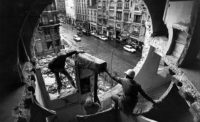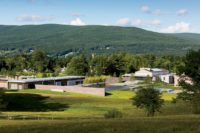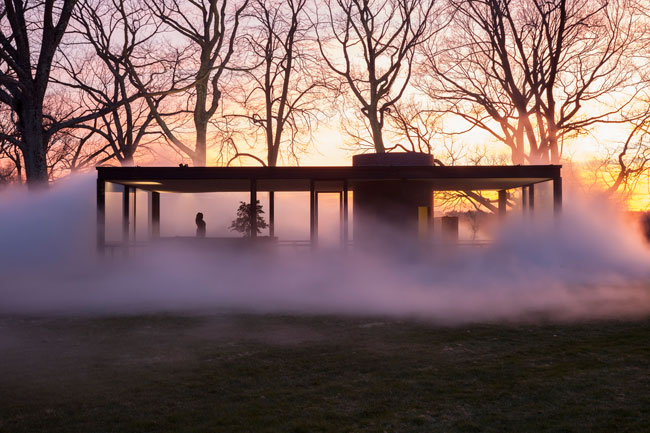Beyond Gordon Matta-Clark
Contemporary crossovers between art, architecture, and preservation.








Parallel currents in art, architecture, and preservation are now leading to a rise in projects that leave existing structures intact while producing radical transformation. Many artists and architects are frustrated with the endless production of novel objects, and are looking to architectural intervention to define alternative modes of authorship and sidestep cycles of resource depletion. At the same time, preservationists are seeing the cultural and economic limitations of static conservation and are embracing more flexible reinventions of historic buildings. Although artists, architects, and preservationists have been performing adaptive reuse for decades, new projects are pursuing more nuanced and conceptual tactics, aiming not only to reuse but also to challenge our understanding of history and existing institutions.
The field of preservation has dramatically transformed in the last decade, as the preservation journal Future Anterior, the Harvard Graduate School of Design’s Critical Conservation program, and Rem Koolhaas’ exhibition Cronocaos, have called attention to the inherent political and cultural biases of the field. But the acknowledgement of such biases also opens up preservation as a creative act. Jorge Otero-Pailos, an architect, artist, scholar and the founder of Future Anterior, has described Gordon Matta-Clark as an important model for “creative agents,” who can produce a second or third conceptual framework for a building after that of its intended author(4). Embracing the idea of historic buildings as open works, stewards of historic landmarks have recently sponsored an abundance of artistic interventions, including projects by Xavier Veilhan at the Neutra VDL House, Santiago Borja at the Villa Savoye, and Fujiko Nakaya at the Glass House. The artist Rudolf Stingel enacted particularly memorable interventions in both the Neue Nationalgalerie in 2010 and the Palazzo Grassi in 2012. For the Neue Nationalgalerie, he covered the entire floor of the main hall with an ornate, custom black-and-white carpet, the expansiveness of which both exaggerated the scale of the hall and offered a contrasting mirror to the infinite grid of Mies’ ceiling. For the Palazzo Grassi exhibition, he covered both the floors and walls of the 18th-century enfilade galleries with red Ottoman carpets, producing a non-white-cube background for his solo exhibition and a surreal continuity of space through sequential rooms. In both cases, the overlay of a new material exaggerated the existing architectural qualities, calling attention to the historical specificity of the space while collapsing old and new into a surreal simultaneity.
In contrast to rarefied projects in historic landmarks, many artists are enacting both conceptual and social transformations through strategic changes to everyday buildings. In 2004, the artist Mark Allen (a former student of Michael Asher) took over a modest commercial space in downtown Los Angeles to establish Machine Project as a venue for site-specific installations, performances, and events. After the initial appropriation, Allen curated successive interventions, including Nate Page’s project Storefront Plaza in 2012. Page moved the storefront windows 20 feet back into the interior, creating a bright red exterior room that functioned as both an event space and an extension of the street. The simple act of moving the storefront pulled public space deep into the interior and created a zone of overlap between the neighborhood and the institution, with the glass wall between producing intimate and voyeuristic friction. Also operating through appropriation but at an even larger scale, the artist Rick Lowe founded the Houston-based Project Row Houses in 1993 by converting 22 abandoned shotgun houses into venues for site-specific art and housing for young mothers. Every year, artists produce new experiential environments within the houses, as with Valerie Piraino’s installation in 2014, for which she juxtaposes the white-painted wood walls of the interior with new “walls” of white fabric with wood texture, creating a quiet rearrangement of the given domestic space. Where the interventions of the 1970s by Matta-Clark and Asher were often attacks on institutions, their methods are now being appropriated in the construction of self-reflexive cultural spaces based on continuous transformation.
Combining adaptive reuse with institutional critique, contemporary architects are using minimal insertions to provocatively reframe historic architecture. Large firms such as OMA, Herzog and De Meuron, and Diller Scofidio + Renfro have been producing edgy reuse projects for decades, but many of these projects still rely on postmodernist tropes of facadism and pastiche, assembling pieces of historic and contemporary architecture into high-contrast collage. Emerging practices, however, are moving away from collage, looking to minimalism and conceptual art for guidance. In 2011, the Belgian office tcct (Cindy Tirry & Tom Callebaut) transformed a historic chapel in Grand-Bigard into a space of pure white austerity. Leaving the historic structure and materiality of the chapel intact, they built a grid of solid, white panels in front of the interior walls and covered the floor with white sand. Entering the space, the viewer sees nothing but pure white surfaces, but visitors can open the panels to reveal the altar or stained glass windows now framed by the panel grid. The perception of the historic building becomes interactive, with multiple possible configurations of obscuring and revealing. Operating between art, architecture, and preservation, such projects offer a new direction for architecture. As practitioners are able to create entirely new forms and spaces through the strategic manipulation of existing structures, they escape longstanding conventions of authorship and construction. Learning from Matta-Clark and Asher, creators across art, architecture, and preservation are performing the magic trick of doing more while doing less.
Bryony Roberts is an artist, architect, and writer based in Los Angeles. She is the principal of Bryony Roberts Studio, a design and research practice focusing on experimental preservation, and she teaches architecture at SCI-Arc.
END NOTES
1. Gordon Matta-Clark: Splitting the Humphrey Street Building," An Interview by Liza Bear, in Gordon Matta-Clark, Ed. Corinne Diserens (London: Phaidon, 2003), 165.
2. Pamela Lee, “On the Holes of History,” in Object to Be Destroyed: The Work of Gordon Matta-Clark (Cambridge: MIT Press, 2000), 169.
3. Gordon Matta-Clark: Splitting the Humphrey Street Building," An Interview by Liza Bear, in Gordon Matta-Clark, Ed. Corinne Diserens (London: Phaidon, 2003), 167.
4. Jorge Otero-Pailos, “Creative Agents,” Future Anterior, vol.3, no.1 (Summer 2006): v.









